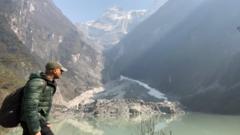The majestic heights of the Himalayas, a defined aspect of Nepali identity and a prime tourist attraction, are becoming harder to glimpse amidst a pervasive haze. On a recent trip, memories of the breathtaking views I once cherished faded into air thick with pollution, frustrating both locals and tourists alike.
During my visit to Kathmandu, the air was not the typically pristine environment I yearned for. The oppressive smog was so dense that my international flight had to circle overhead multiple times before landing—visibility remained critically low as I tried to get a good look at the mountains from my hotel room. Each day in Nagarkot, known for its panoramic views, yielded nothing but haze, discouraging even the most dedicated travelers.
Yogendra Shakya, who has operated a hotel in Nagarkot since 1996, lamented the loss of once-popular sunrise and sunset views, saying, "I can't market for views of the Himalayas anymore; now history and culture have to take precedence." His sentiment echoes the frustrations of many who have built livelihoods around the allure of the mountains.
Hazy skies have become a regular occurrence, with severe air pollution caused by industrial emissions, construction dust, and agricultural burning blocked by prevailing weather conditions. The dry season, which is growing in length due to climate change, traps pollutants, resulting in low visibility even during periods that historically boasted clear skies.
Lucky Chhetri, a pioneering female trekking guide, noted a staggering 40% drop in tourism revenue due to the unpleasant atmospheric conditions. Visitors like John Carroll, who had visited over a dozen times since 1986, remarked on the profound disappointment of not experiencing the stunning Himalayan views now hidden behind a curtain of haze.
The detrimental effects are not isolated to Nepal. Operators in neighboring India report similar issues, with increased haze disrupting their business. In contrast, western Pakistan has remained somewhat shielded, though even there, historic visibility has diminished.
Public health is also suffering from the region's poor air quality, a major contributor to travel disruptions and dangerous living conditions. The future looks grim as experts predict an ongoing rise in hazy days, attributed to both local activities and climate change.
In a world where breathtaking Himalayan views could soon only exist in memories, trekking leaders like Ms. Chhetri voice their collective distress: "We are left with guilt when we cannot deliver the majestic mountains our clients have paid for." As environmental conditions continue to decline, the Himalayas may increasingly become an elusive dream rather than a sight to behold.

















